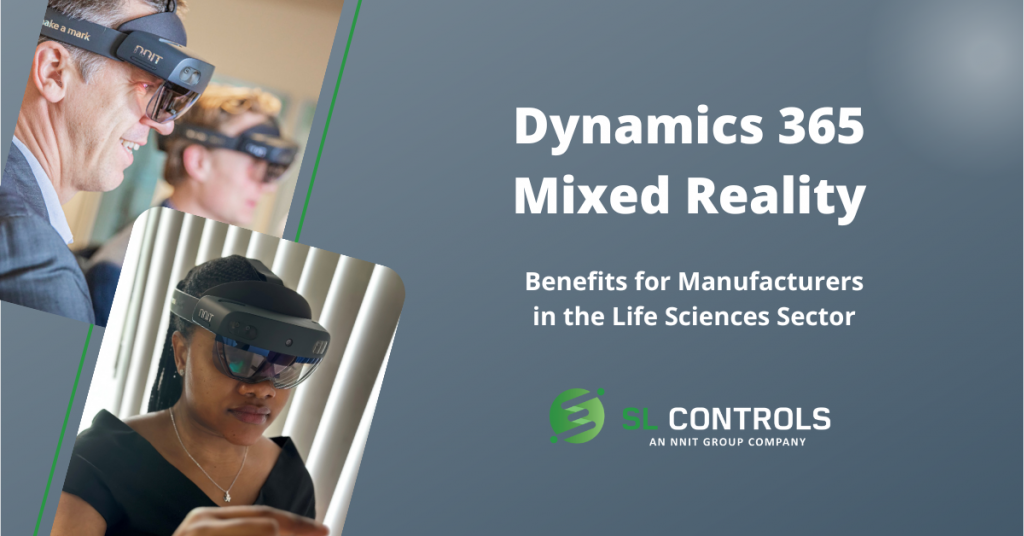Cutting-edge technologies are helping manufacturers in the life sciences sector improve productivity while also addressing challenges – challenges that include skills availability, product quality consistency, production oversight, and OEE (a measure of equipment and overall production line performance). Examples of these cutting-edge solutions include Manufacturing Execution Systems, process automation solutions, and equipment systems integration solutions. Another example that doesn’t get as much attention is mixed reality.
Mixed reality technologies have a low capital investment requirement that can produce impressive results. Before looking at how mixed reality can benefit manufacturers in the life sciences sector, let’s first define what mixed reality is and the main technologies that are available.
What is Mixed Reality?
Mixed reality (MR) is the lesser-known sibling of virtual reality (VR) and augmented reality (AR). You typically use a headset with all three technologies. VR involves entering a completely virtual environment. AR, on the other hand, keeps you in the real world and overlays it with digital content. What about MR?
MR takes AR a stage further, creating a range of opportunities for life sciences manufacturers. Not only does it overlay digital content onto the real world, but it lets that digital content interact with physical objects. Users can also interact with the digital content, including moving and manipulating digital objects and holograms.
What is Microsoft HoloLens?
Microsoft HoloLens is a leading mixed reality technology that offers a range of features that bring benefits to life sciences manufacturers. For example, it recognises hand gestures to make digital objects act like physical objects. It also has built-in voice support and highly precise spatial mapping capabilities.
Plus, as HoloLens is a Microsoft product, it also seamlessly integrates with other Microsoft tools and technologies, including Power Apps, Dynamic 365 Guides, and Microsoft Teams.
Applications for Mixed Reality Technologies in Medical Device and Pharmaceutical Manufacturing
Quality vs Compliance Training
The root cause of many customer complaints and CAPAs (corrective and preventive actions) in life science manufacturing is often misdiagnosed as human error, and the corrective action is typically a retraining procedure. In many cases, however, the real root cause is inadequate competence levels. Up until recently, we did not have platforms to properly measure and monitor competence. Microsoft HoloLens, together with Microsoft Community training, creates an immersive and highly interactive training experience, making it an ideal solution for improving and monitoring the competence of resources.
These technologies are key enablers of a paradigm shift that allows the industry to move the needle away from being overly focused on compliance and back towards quality, restoring the equilibrium between these two important concepts.
Furthermore, SOP training created on Microsoft HoloLens devices ensures all staff receive the same quality of training, plus it is straightforward to keep the training up to date if the SOP changes. The technology also enables Just-in-Time Competence.
Our Parent company, NNIT, has been working with this cutting-edge technology. The NNIT Mixed reality team, headed by Kasper Kronmann Nielsen, has created a whitepaper on the Microsoft learning platform. It explains how to achieve the Dynamics 365 Guides mixed reality for regulated industries.
Remote Support
Traditionally, getting support for manufacturing equipment involved a specialist engineer travelling to your facility. At best, this could take hours and considerably longer if the engineer wasn’t in your region, country, or even continent. Remote support solutions eliminate unnecessary delays, but the quality of support can be fragmented and inconsistent. This is because of the challenge of replicating the experience of a specialist engineer actually being on-site.
Until the introduction of Microsoft HoloLens, that is. By utilising the HoloLens, a specialist engineer can see through the eyes of a technician on-site to deliver accurate instructions to resolve the problem. The engineer can even demonstrate how to carry out a task using a digital object that the on-site technician can replicate in the real world using the physical object. The process can also be recorded on the device as a knowledge asset and for training. The application that enables this functionality is called the Dynamics 365 remote assist.
Benefits of Mixed Reality Technologies for Medical Device and Pharmaceutical Manufacturers
The main benefits of mixed reality technologies for SOP training in the life sciences sector include:
- Employees enjoy immersive training experiences with realistic simulations.
- The training platform is highly interactive, so employees learn by doing. Evaluations can also be created to verify and validate that users understand the training and can improve their competency.
- The training can be completed in any location, improving the efficiency of the training process, and reducing costs.
- The training is completed in a safe and controlled way, so will not impact live production lines or processes.
For remote support applications, Microsoft HoloLens offers a range of benefits:
- Real-time support with specialist engineers that involve no unnecessary waiting or travelling.
- Reduced downtime because of the elimination of unnecessary waiting time for specialist engineers to support an equipment event.
- Support is received hands-free unlike, for example, using a phone to engage with a remote support engineer, where one hand is occupied holding the phone. The hands-free nature of mixed reality technologies means technicians receiving the support can use their hands to complete tasks and follow instructions.
- Improved quality of support as the specialist engineer can see and experience exactly what is happening with the machine or equipment.
- Reduced costs as you eliminate call-outs and related fees.
Summary
Microsoft HoloLens brings the holograms you see in science fiction movies to real life with practical applications in pharmaceutical and medical device manufacturing facilities. Whether you use this technology for remote support, training, or both, the benefits are impressive, and you can expect a rapid return on investment.





